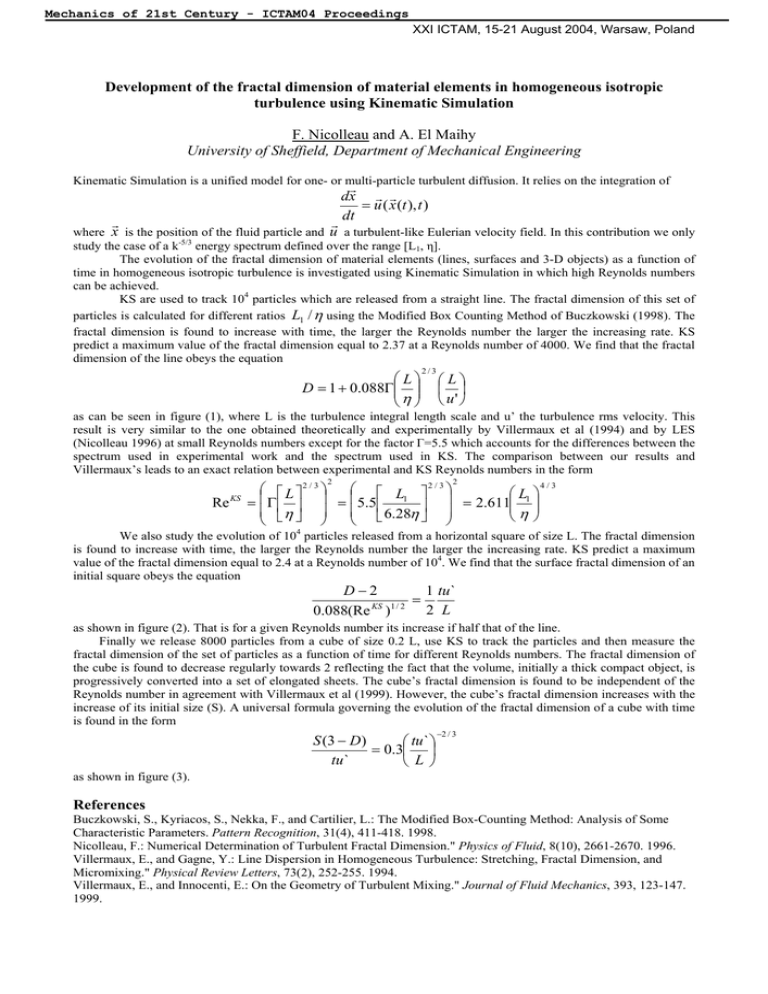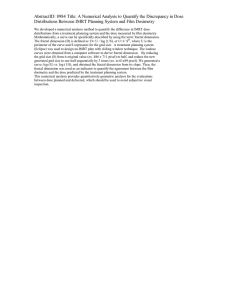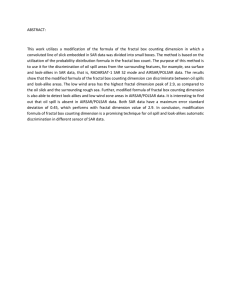Development of the fractal dimension of material elements in homogeneous... turbulence using Kinematic Simulation
advertisement

Mechanics of 21st Century - ICTAM04 Proceedings XXI ICTAM, 15-21 August 2004, Warsaw, Poland Development of the fractal dimension of material elements in homogeneous isotropic turbulence using Kinematic Simulation F. Nicolleau and A. El Maihy University of Sheffield, Department of Mechanical Engineering Kinematic Simulation is a unified model for one- or multi-particle turbulent diffusion. It relies on the integration of r dx r r = u ( x (t ), t ) dt r r where x is the position of the fluid particle and u a turbulent-like Eulerian velocity field. In this contribution we only study the case of a k-5/3 energy spectrum defined over the range [L1, η]. The evolution of the fractal dimension of material elements (lines, surfaces and 3-D objects) as a function of time in homogeneous isotropic turbulence is investigated using Kinematic Simulation in which high Reynolds numbers can be achieved. KS are used to track 104 particles which are released from a straight line. The fractal dimension of this set of particles is calculated for different ratios L1 / η using the Modified Box Counting Method of Buczkowski (1998). The fractal dimension is found to increase with time, the larger the Reynolds number the larger the increasing rate. KS predict a maximum value of the fractal dimension equal to 2.37 at a Reynolds number of 4000. We find that the fractal dimension of the line obeys the equation L D = 1 + 0.088Γ η 2/3 L u' as can be seen in figure (1), where L is the turbulence integral length scale and u’ the turbulence rms velocity. This result is very similar to the one obtained theoretically and experimentally by Villermaux et al (1994) and by LES (Nicolleau 1996) at small Reynolds numbers except for the factor Г=5.5 which accounts for the differences between the spectrum used in experimental work and the spectrum used in KS. The comparison between our results and Villermaux’s leads to an exact relation between experimental and KS Reynolds numbers in the form 2 Re KS 2 4/3 L 2 / 3 L 2 / 3 L 1 1 = 2.611 = Γ = 5.5 η η 6.28η We also study the evolution of 104 particles released from a horizontal square of size L. The fractal dimension is found to increase with time, the larger the Reynolds number the larger the increasing rate. KS predict a maximum value of the fractal dimension equal to 2.4 at a Reynolds number of 104. We find that the surface fractal dimension of an initial square obeys the equation D−2 1 tu ` = KS 1 / 2 2 L 0.088(Re ) as shown in figure (2). That is for a given Reynolds number its increase if half that of the line. Finally we release 8000 particles from a cube of size 0.2 L, use KS to track the particles and then measure the fractal dimension of the set of particles as a function of time for different Reynolds numbers. The fractal dimension of the cube is found to decrease regularly towards 2 reflecting the fact that the volume, initially a thick compact object, is progressively converted into a set of elongated sheets. The cube’s fractal dimension is found to be independent of the Reynolds number in agreement with Villermaux et al (1999). However, the cube’s fractal dimension increases with the increase of its initial size (S). A universal formula governing the evolution of the fractal dimension of a cube with time is found in the form S (3 − D) tu ` = 0.3 tu ` L −2 / 3 as shown in figure (3). References Buczkowski, S., Kyriacos, S., Nekka, F., and Cartilier, L.: The Modified Box-Counting Method: Analysis of Some Characteristic Parameters. Pattern Recognition, 31(4), 411-418. 1998. Nicolleau, F.: Numerical Determination of Turbulent Fractal Dimension." Physics of Fluid, 8(10), 2661-2670. 1996. Villermaux, E., and Gagne, Y.: Line Dispersion in Homogeneous Turbulence: Stretching, Fractal Dimension, and Micromixing." Physical Review Letters, 73(2), 252-255. 1994. Villermaux, E., and Innocenti, E.: On the Geometry of Turbulent Mixing." Journal of Fluid Mechanics, 393, 123-147. 1999. Mechanics of 21st Century - ICTAM04 Proceedings XXI ICTAM, 15-21 August 2004, Warsaw, Poland 0.45 0.4 KS Re=18 KS Re=33 KS Re=120 KS Re=464 KS Re=1000 KS Re=2000 KS Re=4000 Experimental Re=18 Experimental Re=33 LES Re=120 Theoritical Line (D-1)/(0.088 Γ(L/η) 2/3 ) 0.35 0.3 0.25 0.2 0.15 0.1 0.05 0 0 0.1 0.2 0.3 0.4 0.5 0.6 tu`/L Figure (1): [(D-1)/0.088Re1/2] as a function of (t/td) for experimental, LES and KS results. 0.35 2(D-2)/(0.088Γ (L/η )2/3) 0.3 0.25 Re=120 Re=464 Re=1000 Re=2000 Re=4000 Re=10000 Theoritical Line 0.2 0.15 0.1 0.05 0 0 0.05 0.1 0.15 tu`/L 0.2 0.25 0.3 0.35 Figure (2): [2(D-1)/0.088 Γ(L/η)2/3] as a function of (t/td) for different Reynolds numbers. 100 10 d(3-D)/tu` d=0.15 d=0.2 d=0.25 1 0.1 0.001 0.01 0.1 1 tu`/L Figure (3): << session d (3 − D) as a function of tu`/L for different source diameters. tu` << start




